sat的知识点总结
Algebra
1. Concept
Powers of Numbers
Roots of numbers
2. Powers







3. Exponents, roots, and real number line.
Raising numbers to powers can have surprising effects on the size or sign of the base number. This is one of the test-makers` favourite areas! The impact of raising a number to an exponent depends on the region on the number line where the number and exponent fall. Here are the four regions you need to consider;
(1) Less than -1
(2) Between -1 and 0
(3) Between 0 and 1
(4) Greater than 1
As with exponents, the root of a number can bear a surprising relationship to the size and sign of the number. Here are our observations you should remember.
(1) If n>1 ,  (the higher the roots, the higher the value.)
(the higher the roots, the higher the value.)
(2) The square root of any negative number is an imaginary number, not a real number. Remember: you won`t encounter any imaginary numbers on the SAT.
(3) Every positive number has two square roots: a negative number and a positive number (with the same absolute value). The same holds true for all other even-numbered roots of positive numbers.
(4) Every negative number has exactly one cube root, and that root is a negative number. The same holds true for all other odd-numbered roots of negative numbers.
(5) Every positive number has only one cube root, and that root is always a positive number. The same holds true for all other odd-numbered root of positive numbers.
4. The Operation Rule of Radicals
Combining Radicals
(1) Addition and Subtraction: if a term under a radical is being added to or subtracted from a term under a different radical, you cannot combine the two terms under the same radical.
(2) Multiplication and Division: terms under different radicals can be combined under a common radical if one term is multiplied or divided by the other, but only if the root is the same.
Simplifying Radicals
On the SAT, always look for the possibility of simplifying radicals by moving part of what`s inside the radical to the outside. Check inside your square-root radicals for factors that are squares of nice tidy numbers (especially integers).
5. Function
(1) Liner Equation with One Variable
Algebraic expressions are exactly used to form equations, which set two expressions equal to each other. Most equations you`ll see on the SAT are linear equations, in which the variables don`t come with exponents. To sole any liner equation containing one variable, your goal is always the same; the unknown (variable) on one size of the equation. To accomplish this, you may need to perform one or more of the following operations on both sides, depending on the equation.
Add or subtract the same term both sides of the equation
Multiply of divided both sides of the equation by the same non-zero term.
If each side of the equation is a fraction, your best bet is to cross-multiply.
Square both sides of the equation to eliminate radical signs.
(2) Linear Equations with Two Variables
The substitution method
The addition-subtraction method
(3) Quadratic equation with one variable
An equation is quadratic if you can express it in this general form:  .
.
In this general form, x is the variable, a, b and c are constants (numbers),  , b and c can equal 0. Every quadratic equation has exactly two solutions. (These two solutions are called roots.) All quadratic equations on the SAT can be solved by factoring.
, b and c can equal 0. Every quadratic equation has exactly two solutions. (These two solutions are called roots.) All quadratic equations on the SAT can be solved by factoring.
Factorable quadratic equations with one variable
To solve any factorable quadratic equation with one variable, follow these three steps:
(1) put the equation into the standard form:  .
.
(2) Factor the terms on the left side of the equation into two linear expression (with no exponents).
(3) Set each linear expression (root) equal to zero solve for the variable in each one.
6 Series
7 the Motion of the Graph of Function
Functions with similar equations tend to have similar shapes. For instance, functions of the quadratic form  have graphs that look like parabolas. You also should know how specific changes to the function equation produce specific changes to the graph. Learn how to recognize basic transformations of functions: shifts and reflections.
have graphs that look like parabolas. You also should know how specific changes to the function equation produce specific changes to the graph. Learn how to recognize basic transformations of functions: shifts and reflections.
(1) Horizontal motion:  means that the graph moves left k units while
means that the graph moves left k units while  the graph moves right k units.
the graph moves right k units.
(2) Vertical motion:  means means that the graph moves upward k units while
means means that the graph moves upward k units while  means the graph moves right k units.
means the graph moves right k units.
(3) Reflections: when the point (x,y) is reflected over the y axis, it becomes (-3,4). That is, the x coordinate is negated. When it is reflected over the x axis, it becomes (3,-4). That is, the y coordinate is negated. Likewise., if the graph of  is reflected over the x axis, it becomes
is reflected over the x axis, it becomes  .
.
第二篇:圆的知识点总结
圆
圆的知识结构图:
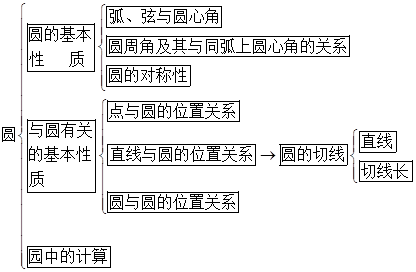
一、圆的基本元素:
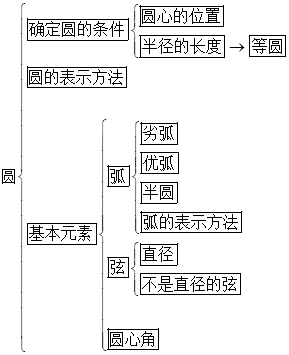
(一)确定圆的条件是圆心的位置和半径的长度,圆心相同,半径长度相同的两个圆为等圆。
圆的表示方法:以点 为圆心的圆叫做“圆
为圆心的圆叫做“圆 ”,记作
”,记作 。
。
圆的基本元素:包括弦、弧、圆心角等,其中直径是过圆心的弦;半圆是直径所对的弧,弧还包括优弧和劣弧。优弧是较长的弧,表示为 ,劣弧是较短的弧,表示为
,劣弧是较短的弧,表示为 。
。
顶点在圆心的角叫做圆心角。
圆的对称性:

(二、)圆即是轴对称图形,又是中心对称图形
在一个圆中,如果圆心角相等,那么它所对的弧相等,所对的弦相等。
在一个圆中,如果弧相等,那么它所对的圆心角相等,所对的弦相等。
在一个圆中,如果弦相等,那么它所对的圆心角相等,所对的弧相等。
垂径定理:垂直于弦的直径,平分这条弦,并且平分这条弦所对的弧。
圆周角:

圆周角:定点在圆上,并且两边都和圆相交的角,叫做圆周角。
(1) 定点在圆上
(2) 两边都与圆相交
圆周角定理:一条弧所对的圆周角等于它所对的圆心角的一半。
推论1:在同一圆内同弧或等弧所对的圆周角相等,相等的圆周角所对的弧也相等;
推论2:半圆(直径)所对的圆周角是直角;  圆周角所对的弦是直径。
圆周角所对的弦是直径。
(注)对于两个相等的圆也有相同的结论
在推论(1)中,“同弧或等弧”改为“同弦或等弦”的话,结论就不成立了,因为一条弦所对的圆周角有两种可能,,在一般情况下是不相等的。
二、与圆有关的位置关系:
(1) 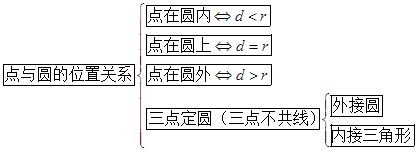
点与圆的位置关系有三种,点在圆内,点在圆上,点在园外;
根据点到圆心的距离 与圆的半径
与圆的半径 的大小关系,来判断点与圆的位置关系;
的大小关系,来判断点与圆的位置关系;
三点定圆的条件是三点不共线;
经过三角形三个顶点的圆叫做三角形的外接圆;三角形的外接圆的圆心叫做这个三角形的外心;在个三角形叫做这个圆的内接三角形。三角形的外心就是三角形三边的中垂线的交点。
说明:
【1】三角形的外心可以在三角形的内部、外部或一边上
锐角三角形—外心在三角形内部
钝角三角形—外心在三角形外部
直角三角形—外心在三角形是斜边上的中点
【2】外心到三角形三顶点距离相等
(2) 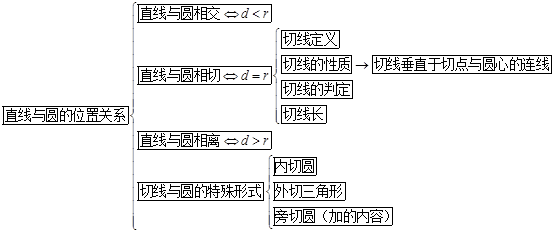
直线与圆相交即直线与圆有两个交点
直线与圆相离即直线与圆没有交点
直线与圆相切即直线与圆有一个交点
若一条直线与一个圆有且只有一个交点,那么我们称这条直线为这个圆的切线,这个交点叫做直线与圆的切点。
切线的性质:
切线的判定:
切线长:过圆外一点做圆的切线,这个点与切点的距离叫做这个点与圆的切线长。
切线长性质:若过圆外一点向圆引两条切线,那么这一点到圆两个切点的距离一样长。
切线长定理:从圆外一点引圆的两条切线,它们的切线长相等,圆心与这一点的连线平分这两条切线的夹角。
若三角形内有一圆与三角形三边都相切,则这个圆叫做三角形的内切圆,这个三角形叫做这个圆的外切三角形,内切圆的圆心叫做三角形的内心。
三角形的内心即为三角形三条角平分线的交点。
说明:三角形内心到三角形三边距离相等
三角形内心与三角形顶点的连线平分这个内角
(3)
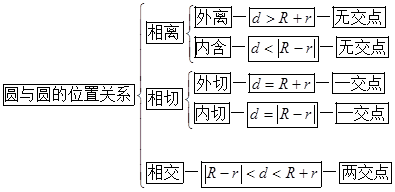
圆心距是指两圆圆心之间的线段长
同心圆是指圆心距为0的两个圆
连心线是指两圆圆心确定的直线
相切两圆的性质:相切的两圆的连心线必过切点,即两圆圆心、切点在一条直线上
两圆的公共切线叫做公切线
-
《Java知识点总结系列》第三章——程序的流程控制篇
内容预览顺序流程分支流程循环流程顺序流程以前的程序都是顺序流程,这里略过。分支流程1.if语句a)格式:if(布尔表达式){语句内…
-
JAVA知识点总结
JAVA知识点总结一1Java中一个char类型可以存放一个汉字吗?为什么?可以。因为JVM的最小单位是两个字节,而java中以u…
-
java知识点总结
Java程序设计基础知识点总结1类首字母大写如果一个类名由多个单词构成那么每个单词的首字母都大写中间不使用任何的连接符比如Pers…
-
java各知识点详细总结
Java基础知识总结写代码1明确需求我要做什么2分析思路我要怎么做1233确定步骤每一个思路部分用到哪些语句方法和对象4代码实现用…
-
java基础知识总结(超级经典)1
Java基础知识总结写代码1明确需求我要做什么2分析思路我要怎么做1233确定步骤每一个思路部分用到哪些语句方法和对象4代码实现用…
-
SAT近义词总结(权威版)
SAT近义词同义词总结赞歌、颂词:Encomium/eulogy/anthem/paean/panegyric/tribute赞扬…
-
SAT同义词词汇总结
1.Important=cruciala.至关紧要的(extremelyimportant),significant(amount…
-
海知音--总结SAT写作考试的答题步骤
总结SAT写作考试的答题步骤对于SAT写作考试,很多考生还是比较担心的。相信有不少的同学参加了SAT写作培训班,其实这确实是对大家…
-
SAT常见意群
SectionOne?骗子集团:imposer,masquerader,deceiver,double-dealer,swindl…
-
SAT 意群
安慰。包含,包括。暴露,泄露。暴躁的,易怒的。背叛的。笨拙的。贬低,反对。补偿。不相关的。不重要的。仓促的。忏悔的。常规的。吵闹的…